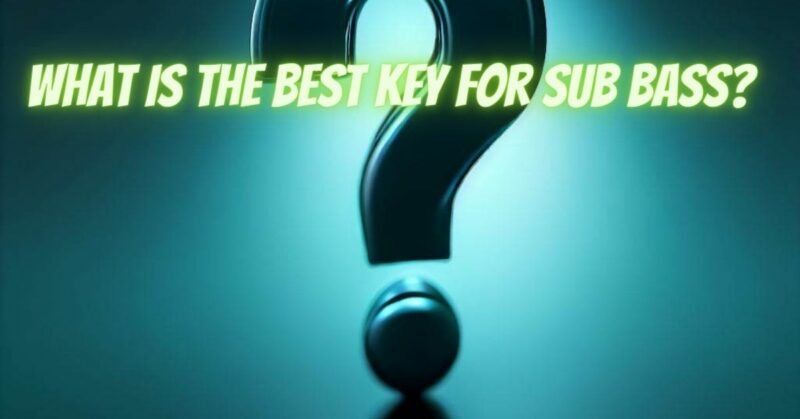Sub bass is the foundation of many music genres, providing a powerful low-end presence that resonates with listeners on a visceral level. When creating sub basslines or selecting the key for a track, musicians and producers often wonder: What is the best key for sub bass? In this article, we’ll explore the factors that influence this decision and help you choose the right key to make your sub bass shine.
Understanding Sub Bass
Sub bass refers to the extremely low frequencies that are typically felt more than heard. These frequencies are often found in the range below 60 Hz and are responsible for the deep, rumbling sensations you experience in your chest at a live concert or in a car with a booming sound system.
Factors Influencing the Best Key for Sub Bass
- Speaker and Subwoofer Response: The choice of key for sub bass can be influenced by the capabilities of the audio equipment you’re using. Different speakers and subwoofers have varying frequency responses and may perform better or worse at specific frequencies. Understanding your gear’s capabilities can help you select a key that maximizes its potential.
- Musical Genre: The best key for sub bass can vary depending on the genre of music you’re creating. For example:
- Electronic dance music (EDM) often features sub basslines in keys like C, D, or G, as these keys align with the resonance of typical subwoofers.
- Hip-hop tracks may use keys like F# or A, which complement the low-end frequencies in sampled beats.
- Rock and metal genres may have sub bass elements in a range of keys, depending on the song’s overall tonal characteristics.
- Emotional Impact: The key you choose can also influence the emotional impact of your music. Lower keys tend to convey a darker, heavier mood, while higher keys can create a more energetic or uplifting vibe. Consider the emotional context of your song when selecting the key for your sub bass.
- Instrumentation: If your sub bass is accompanying other instruments or vocals, the key choice should complement and harmonize with the rest of the music. Ensuring that the sub bass aligns with the overall tonal structure of the composition is essential for a cohesive sound.
Experimentation and Tuning
Ultimately, finding the best key for sub bass may require experimentation and tuning. Here are some tips:
- Experiment with Different Keys: Create versions of your sub bassline in different keys to compare how they sound and feel. Some keys may resonate better with your intended audience or musical style.
- Test with Various Speakers: Listen to your sub bass on different audio systems, including studio monitors, headphones, and car stereos, to ensure it translates well across various listening environments.
- Consider Modulation: In some cases, you may want to modulate the key of your sub bass during different sections of a song to create dynamic shifts and maintain interest.
- Work with a Tuner: If precision is crucial, use a tuner or spectrum analyzer to visualize and fine-tune the sub bass frequencies.
The best key for sub bass can vary depending on a range of factors, including your musical genre, equipment, and emotional intent. There is no one-size-fits-all answer, and the choice often comes down to artistic preference and the overall context of your music. By understanding the principles behind sub bass frequencies and experimenting with different keys, you can create sub basslines that not only resonate deeply but also complement and enhance your music’s unique character.

